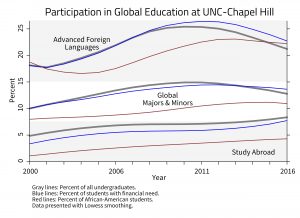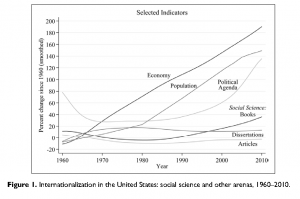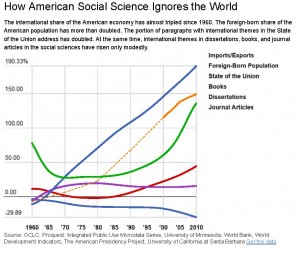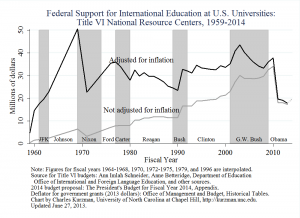International Education
Global Education for All?
 Niklaus Steiner and Charles Kurzman, “Global Education for All?” Center for Global Initiatives, University of North Carolina at Chapel Hill, November 2017. “As global education expands at American colleges and universities, do all of our students have access to these opportunities? Or are we widening the divide between haves and have-nots on our campuses, with students from privileged backgrounds taking advantage of such opportunities, while other students are unable or unwilling to do so? This concern lies at the intersection of two great priorities in American higher education today: global and equity.” More…
Niklaus Steiner and Charles Kurzman, “Global Education for All?” Center for Global Initiatives, University of North Carolina at Chapel Hill, November 2017. “As global education expands at American colleges and universities, do all of our students have access to these opportunities? Or are we widening the divide between haves and have-nots on our campuses, with students from privileged backgrounds taking advantage of such opportunities, while other students are unable or unwilling to do so? This concern lies at the intersection of two great priorities in American higher education today: global and equity.” More…
Scholarly Attention and the Limited Internationalization of US Social Science
 Charles Kurzman, “Scholarly Attention and the Limited Internationalization of US Social Science,” International Sociology, Vol. 32, No. 6, November 2017, pp. 775-795, first posted October 10, 2017. “What parts of the world does American social science consider worthy of scholarly attention? Analyzing the geographic focus of more than 2 million bibliographic records of journal articles, books, and dissertations, the study finds a weak trend toward internationalization of US social-scientific attention over the past half-century.” More…
Charles Kurzman, “Scholarly Attention and the Limited Internationalization of US Social Science,” International Sociology, Vol. 32, No. 6, November 2017, pp. 775-795, first posted October 10, 2017. “What parts of the world does American social science consider worthy of scholarly attention? Analyzing the geographic focus of more than 2 million bibliographic records of journal articles, books, and dissertations, the study finds a weak trend toward internationalization of US social-scientific attention over the past half-century.” More…
Replication data is available at the UNC Data Archive.
Crossword Cosmopolitanism
 Charles Kurzman, “What Crossword History Tells Us About the Language We Use,” New York Times, February 7, 2016. “We are more parochial than our grandparents’ generation, according to one indicator: The New York Times Crossword Puzzle. With the permission of Will Shortz, the Times’s puzzle editor, I recently downloaded all of the newspaper’s crosswords, from February 1942, when the puzzle began, through the end of 2015. I created an algorithm to search all 2,092,375 pairs of clues and answers for foreign language words and place names outside the United States.” More…
Charles Kurzman, “What Crossword History Tells Us About the Language We Use,” New York Times, February 7, 2016. “We are more parochial than our grandparents’ generation, according to one indicator: The New York Times Crossword Puzzle. With the permission of Will Shortz, the Times’s puzzle editor, I recently downloaded all of the newspaper’s crosswords, from February 1942, when the puzzle began, through the end of 2015. I created an algorithm to search all 2,092,375 pairs of clues and answers for foreign language words and place names outside the United States.” More…
- The article’s charts and methods, for those who are interested, can be found here.
How Global Is K-12 Education in America?
| International Content in K-12 Standards |
||
|---|---|---|
| Rank | State | Percent of Standards |
| 1 | Louisiana | 100 |
| 2 | New Hampshire | 100 |
| 3 | Kansas | 87.1 |
Charles Kurzman, “How Global Is K-12 Education in America?” April 30, 2015. Ready or not, our children will be launched into a big wide world of global interconnectedness. How well are their schools preparing them for this transnational era? One measure can be found in state standards for history and social studies, which have been conveniently collected on the website TeachingHistory.org. It turns out that some states pay far more attention to global education than others. Leading the way are Louisiana and New Hampshire, which include a global element in all of their history and social studies standards. Rather than draw students’ attention to multiple scales, from local to global, too many states set standards that focus only on one scale at a time, segregating the United States from the rest of the world. More…
The Stubborn Parochialism of American Social Science

Crippling International Education
 Charles Kurzman, “Crippling International Education,” April 26, 2013. “Federal funding for international education has never been so poor. This year’s 5% percent sequestration, on top of a 47% cut in 2011, has brought the Department of Education’s National Resource Centers to their lowest level of support in half a century. (See chart.) As Congress begins to consider revisions to the Higher Education Act, which expires at the end of this year, it has an opportunity to reinvest in international education. This week, President Obama proposed a 9 percent increase in international education and foreign language studies, but this hardly reverses the cuts this program has suffered.” More…
Charles Kurzman, “Crippling International Education,” April 26, 2013. “Federal funding for international education has never been so poor. This year’s 5% percent sequestration, on top of a 47% cut in 2011, has brought the Department of Education’s National Resource Centers to their lowest level of support in half a century. (See chart.) As Congress begins to consider revisions to the Higher Education Act, which expires at the end of this year, it has an opportunity to reinvest in international education. This week, President Obama proposed a 9 percent increase in international education and foreign language studies, but this hardly reverses the cuts this program has suffered.” More…
b